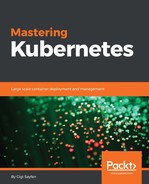- Mastering Kubernetes
- Table of Contents
- Mastering Kubernetes
- Credits
- About the Author
- About the Reviewer
- www.PacktPub.com
- Customer Feedback
- Preface
- 1. Understanding Kubernetes Architecture
- 2. Creating Kubernetes Clusters
- 3. Monitoring, Logging, and Troubleshooting
- 4. High Availability and Reliability
- High-availability concepts
- High-availability best practices
- Live cluster upgrades
- Large-cluster performance, cost, and design trade-offs
- Summary
- 5. Configuring Kubernetes Security, Limits, and Accounts
- 6. Using Critical Kubernetes Resources
- Designing the Hue platform
- Using Kubernetes to build the Hue platform
- Separating internal and external services
- Using namespace to limit access
- Launching jobs
- Kubectl get pods
- Mixing non-cluster components
- Employing init containers for orderly pod bring-up
- Evolving the Hue platform with Kubernetes
- Summary
- 7. Handling Kubernetes Storage
- Persistent volumes walkthrough
- Public storage volume types - GCE, AWS, and Azure
- GlusterFS and Ceph volumes in Kubernetes
- Flocker as a clustered container data volume manager
- Integrating enterprise storage into Kubernetes
- Summary
- 8. Running Stateful Applications with Kubernetes
- Stateful versus stateless applications in Kubernetes
- Shared environment variables versus DNS records for discovery
- Running a Cassandra cluster in Kubernetes
- Summary
- 9. Rolling Updates, Scalability, and Quotas
- Horizontal pod autoscaling
- Performing rolling updates with autoscaling
- Handling scarce resources with limits and quotas
- Choosing and managing the cluster capacity
- Pushing the envelope with Kubernetes
- Summary
- 10. Advanced Kubernetes Networking
- Understanding the Kubernetes networking model
- Kubernetes networking solutions
- Using network policies effectively
- Load balancing options
- Writing your own CNI plugin
- Summary
- 11. Running Kubernetes on Multiple Clouds and Cluster Federation
- Understanding cluster federation
- Managing a Kubernetes cluster federation
- Setting up cluster federation from the ground up
- Initial setup
- Using the official hyperkube image
- Running the federation control plane
- Registering Kubernetes clusters with federation
- Updating KubeDNS
- Shutting down the federation
- Setting up cluster federation with Kubefed
- Running federated workloads
- Summary
- 12. Customizing Kubernetes - API and Plugins
- Working with the Kubernetes API
- Extending the Kubernetes API
- Writing Kubernetes plugins
- Writing an authorization plugin
- Summary
- 13. Handling the Kubernetes Package Manager
- 14. The Future of Kubernetes
- Index
In this chapter, we covered three major topics: working with the Kubernetes API, extending the Kubernetes API, and writing Kubernetes plugins. The Kubernetes API supports the OpenAPI spec and is a great example of REST API design that follows all current best practices. It is very consistent, well organized, and well documented. Yet it is a big API and not easy to understand. You can access the API directly via REST over HTTP, using client libraries including the official Python client, and even by invoking Kubectl.
Extending the Kubernetes API involves defining your own third-party-resources. These are most effective when you combine them with additional custom plugins or when you query and update them externally.
Plugins are a foundation of Kubernetes design, and it was always meant to be extended by users to accommodate any needs. We looked at various plugins you can write and how to register and integrate them seamlessly with Kubernetes.
At this point, you should be well aware of all the major mechanisms to extend, customize, and control Kubernetes via API access, third-party-resources, and custom plugins. You are in a great position to take advantage of these capabilities to augment the existing functionality of Kubernetes and adapt it to your needs and your systems.
In Chapter 13, Handling the Kubernetes Package Manager, we'll look at Helm, the Kubernetes package manager, and its charts. As you may have realized, deploying and configuring complex systems on Kubernetes is far from simple. Helm allows grouping together a bunch of manifests into a chart, which can be installed as a single unit.
-
No Comment
